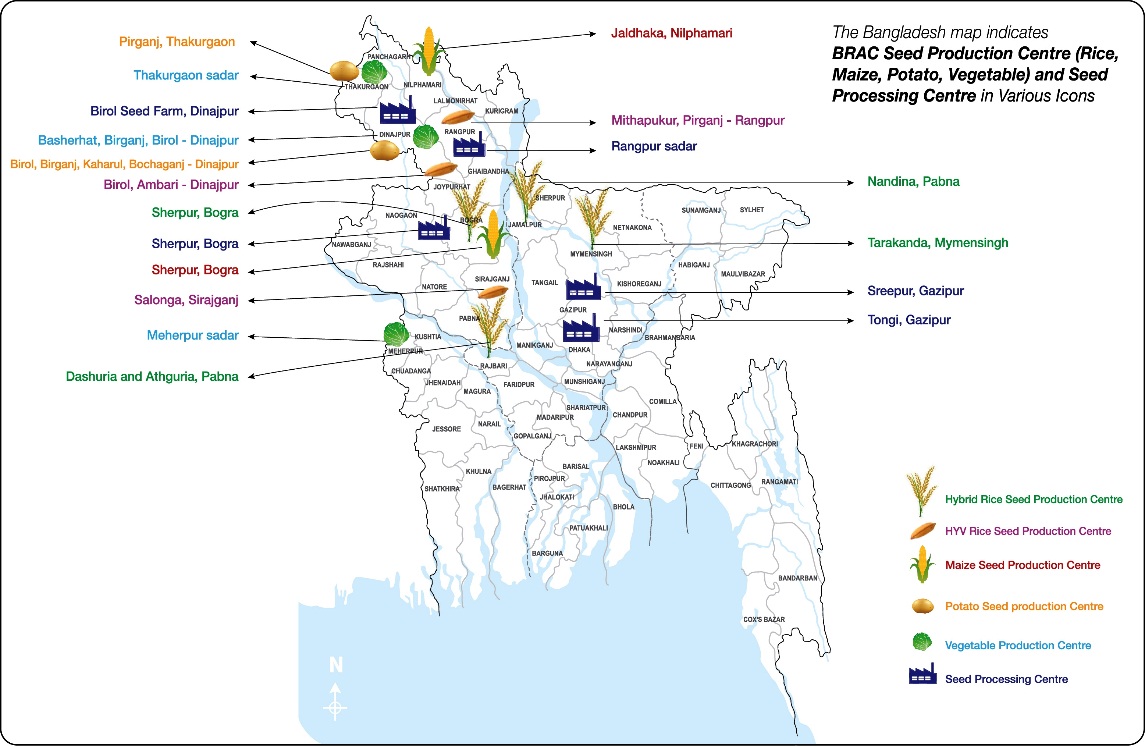BRAC has been working in the agriculture sector since 1972. The objective is to enhance food and nutritional security by ensuring the consistent supply of quality agricultural inputs including resilient varieties, promoting sustainable production technologies and appropriate mechanisation to reduce post-harvest losses.
Quality seeds are one of the necessary factors for high yields. To ensure quality seed supply, BRAC has been marketing hybrid maize seeds since 1994, and hybrid rice seeds since 1998. It also started producing hybrid maize seeds in 1996-97, vegetable seeds in 1996, and hybrid rice seeds in 2001. BRAC has established the value chain system of production and distribution for seeds and other agricultural inputs, allowing the enterprise to offer fair prices to the farmers. BRAC Seed and Agro Enterprise focuses on supplying quality agricultural inputs, appropriate production and post-harvest technologies to enhance production and reduce post-harvest losses to optimise the profit of poor and marginal farmers. Additionally, it is important to BRAC to use sustainable methods, so that agricultural development does not occur at the cost of environment harmony.
BRAC Seed and Agro Enterprise today
BRAC Seed and Agro Enterprise has three agricultural research and development centres in Gazipur, Bogra (Sherpur) and Dinajpur (Birol). The centres are conducting applied research on plant tissue culture, vegetables, rice and maize. It has a soil-testing laboratory with the capacity of testing around 3,000 soil samples per year. Our researchers focus on discovering new varieties that meet the needs of both regional farmers and consumers. BRAC has developed five hybrid rice varieties, four hybrid maize varieties, 10 hybrid vegetable varieties and three open-pollinated vegetable varieties. It has registered 12 hybrid rice exotic varieties through government authorities.
With 22 production centres and about 7,000 contract farmers around the country BRAC is the country’s largest producer of hybrid maize seed and second largest producer of potato seed. It has the largest market share for rice seed (hybrid and high-yielding varieties), maize seed, potato seed and vegetable seed. The seed and agro enterprise has established five seed processing centres with a processing capacity of 12,000 metric tons per year, along with 11 modern storage systems with the capacity of 4,400 metric tons. To ensure high quality seeds, the enterprise uses automatic polymer seed coating treatment (fungicide) and an automatic packaging system. Furthermore, it promotes environment-friendly farming by marketing micronutrients like zinc and boron in order to tackle the rising micronutrient deficiency in soil.
BRAC’s seed and agro enterprise has built the value chain system of production and distribution through a wide network of 450 dealers and more than 4,500 sub-dealers around the country. BRAC Seed and Agro Enterprise is now marketing 26 hybrid varieties and 27 open pollinated varieties of vegetable seed, 13 hybrid varieties and 19 high-yield varieties of rice seed, 14 hybrid varieties of maize seed and 5 varieties potato seed. During the production season 2014-15, the enterprise has marketed 1,600 metric tons hybrid rice seed, 1,300 metric tons high-yielding varieties of rice seed, 590 metric tons hybrid maize seed, 125 metric tons vegetable seeds and 9,600 metric tons potato seeds. In the seed business, BRAC Seed and Agro Enterprise has 19% market share in hybrid rice, 23% in hybrid maize, 36% in potatoes (of organised seed supplied) and 8% in vegetables. In tandem, BRAC is also importing quality seeds regularly to increase the national production of high-yielding varieties invented across the globe.
Besides the core seed business, the seed and agro enterprise is currently working with two projects, ‘agri-business for trade Competitiveness Project (ATC-P) Bangladesh’, which ensures the availability of quality vegetable seeds at hard-to-reach areas and ‘SUSTAIN’, which aims to ensure nutrition-enriched orange flesh sweet potato production and promotion on chars and areas with salty soil and water. Previously, BRAC Seed and Agro Enterprise worked on the USAID Horticulture Project to improve incomes, nutrition and health in Bangladesh through the cultivation of potato, sweet-potato and vegetables. The enterprise also collaborated with CIP, under FoodSTART, for a project funded by IFAD to ensure food security through roots and tuber crops. Another project was conducted in collaboration with Katalyst, under Swisscontact, which involved the promotion of maize cultivation through increasing awareness, access to information and quality inputs in the southern region of the country in order to allow farmers to generate income.
At a glance
3 agriculture research and development centres
22 production centres
5 modern equipped seed processing centres with the capacity of 12,000 metric tons per year
11 modern storage system with the capacity of 4,400 metric tons
5 own developed hybrid rice varieties
4 own developed hybrid maize varieties
10 own developed hybrid vegetable varieties
450 dealers and over 4,500 sub-dealers in supply chain
Marketing 53 varieties of vegetable seed, 13 hybrid varieties, 19 high-yield varieties of rice seed, 14 hybrid varieties of maize seed and 5 varieties of potato seed
Marketing 1,600 metric tons hybrid rice seed, 1,300 metric tons inbreed rice seed, 590 metric tons hybrid maize seed, 9600 metric tons potato seed and 125 metric tons vegetable seed annually


You need to be a member of Bangladesh Royal AI Club link Intel Glasgow1758-Asia-Ed3dao390 to add comments!
Join Bangladesh Royal AI Club link Intel Glasgow1758-Asia-Ed3dao390